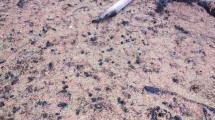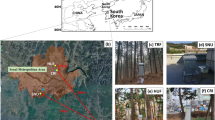Summary
The δ34S value of SO2 emitted by natural gas refineries is about +25, which is higher than that for non-industrial sulfur sources in our study areas. Terrestrial mosses absorb SO2 from the atmosphere and have a δ34S value which is directly related to the degree of SO2 stress to which they are subjected. The δ34S values for conifer needles are lower than for mosses at the same collection site, which indicates that trees obtain sulfur from both atmospheric and soil sources.
Potted conifers were transferred to sites differing in their degree of SO2 stress. This difference is reflected by the change of δ34S values of their needles. SO2 absorbant pot covers, such as charcoal and moss, reduce the amount of airborne sulfur which is available to tress. Moss also may reduce SO2 absorbed by soils in forest stands. We have used analysis of δ34S values to (1) help define SO2 dispersion patterns; (2) reveal the rates at which plants accumulate this pollutant; and (3) associate suspected SO2 injury more closely to an emission source.
Similar content being viewed by others
References
Cronan, C.S., Reiners, W.A., Reynolds, Jr., R.C., Lang, G.E.: Forest floor leaching: contributions from mineral, organic, and carbonic acids in New Hampshire subalpine forests Science 21, 309–311 (1978)
Guderian, R. Air pollution: Phytotoxicity of acidic gases and its significance in air pollution control (transl. by C.J. Brandt), pp. 47. Berlin-Heidelberg-New York: Springer 1977
Hitchon, B., Krouse, H.R.: Hydrogeochemistry of the surface waters of the Mackenzie River drainage basin, Canada. III. Stable isotopes of oxygen, carbon, and sulfur. Geochim. Cosmochim. Acta 36, 1337–1357 (1972)
Huitt, H.A., Lodge, Jr., J.P.: Equilibrium effects in determination of sulfur dioxide with pararosaline and formaldehyde. Anal. Chem. 36, 1305–1308 (1964)
Kershaw, K.A., Larson, D.W.: Studies on lichen-dominated systems. IX. Topographic influences on microclimate and species distribution. Can. J. Bot. 52, 1935–1945 (1974)
Krouse, H.R.: Sulfur isotope studies and their role in petroleum exploration. J. Geochem. Explor. 7, 189–211 (1977a)
Krouse, H.R.: Sulphur isotope abundance elucidate uptake of atmospheric sulphur emissions by vegetation. Nature 265, 45–46 (1977b)
Larson, D.W., Kershaw, K.A.: Studies on lichen-dominated systems. VII. Interaction of the general lichen-heath with edaphic factors. Can. J. Bot. 52, 1163–1176 (1974)
Leach, W.: On the importance of some mosses as pioneers on unstable soils. J. Ecol. 19, 98–102 (1931)
LeBlanc, F., Robitaille, G., Rao, D.N.: Biological response of lichens and bryophytes and bryophytes to environmental pollution in the Murdochville copper mine area, Québec. Jn. Hattori Bot. Lab. 38, 405–433 (1974)
Lowe, L.E., Sasaki, A., Krouse, H.R.: Variation of 34S/32S in soil fractions in Western Canada. Can. J. Soil Sci. 51, 129–131 (1971)
Marsh, W.M., Koerner, J.M.: Role of moss in slope formation. Ecology 53, 489–493 (1972)
Mattsson, S., Lidén, K.: 137Cs in carpets of the forest moss Pleurozium schreberi, 1961–1973. Oikos 26, 323–327 (1975)
Nash III, T.H.: Influence of effluents from a zinc factory on lichens. Ecol. Monog. 45, 183–198 (1975)
Olkkonen, H., Takala, K.: Total sulfur content of an epiphytic lichen as an index of air pollution and the usefulness of the x-ray fluorescence method in sulphur determinations. Ann. Bot. Fennici 12, 131–134 (1975)
Siegfriedt R.K., Wiberly, J.S., Moore, R.W.: Determination of sulfur after combustion in a small oxygen bomb. Anal. Chem. 23, 1008–1011 (1951)
Thode, H.G., Monster, J., Dunford, H.D.: Sulfur isotope geochemistry. Geochim. Cosmochim. Acta 25, 159–174 (1961)
Winner, W.E., Bewley, J.D.: Contrasts between bryophyte and vascular plant synecological responses in an SO2-stressed white spruce association in Central Alberta. Oecologia (Berl.) 33, 311–325 (1978a)
Winner, W.E., Bewley, J.D.: Terrestrial mosses as bioindicators of SO2 pollution stress. Synecological analysis and the index of atmospheric purity. Oecologia (Berl.) 35, 221–230 (1978b)
Wood, Jr., C.W., Nash III, T.N.: Copper smelter effluent effects on Sonoran Desert vegetation. Ecology 57, 1311–1316 (1976)
Author information
Authors and Affiliations
Rights and permissions
About this article
Cite this article
Winner, W.E., Bewley, J.D., Krouse, H.R. et al. Stable sulfur isotope analysis of SO2 pollution impact on vegetation. Oecologia 36, 351–361 (1978). https://doi.org/10.1007/BF00348061
Received:
Issue Date:
DOI: https://doi.org/10.1007/BF00348061




